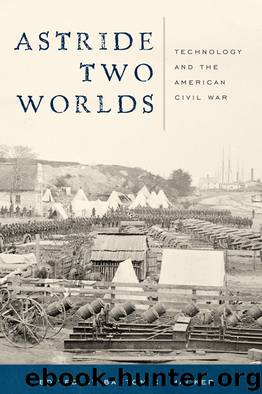Astride Two Worlds by Barton C. Hacker

Author:Barton C. Hacker [Hacker, Barton C.]
Language: eng
Format: epub
ISBN: 978-1-935623-92-2
Publisher: Smithsonian
Published: 2016-05-03T04:00:00+00:00
(See also Wilkes 25 February 1865:403; Holcombe 1881:340.)
While acceptance of trained veterinarians was largely shunned by the army as unnecessary, there were a few hesitant steps in the direction of improving animal healthcare. In May 1861 Congress added a new regular 6th Cavalry regiment, which was authorized to enlist a veterinary sergeant for each of the regiment’s three battalions to be paid $17 per month (AGO 1862). Not until 3 March 1863, however, did Congress finally sanction one veterinary surgeon for each volunteer cavalry regiment to serve at the rank of sergeant-major and to be paid $75 per month (AGO 1863a; O’Brien and Diefendorf 1864, vol. 1:327–328). The act changed little since few professional veterinary surgeons could be induced to enter the army at such a lowly rank.
The army veterinary selection process was further formalized a few months after formation of an official Cavalry Bureau in July 1863. Under the new rules, veterinary surgeons were to be nominated by cavalry regiment commanders, then recommended by a regimental board of three ranking officers, and then forwarded on to the chief of the Cavalry Bureau, who finally submitted it to the Secretary of War for appointment. A record of the appointments kept by the Adjutant-General’s Office shows that between 1863 and 1865 there were approximately 98 applications for appointment as veterinary surgeon, many made during the war’s last year. Most of these applicants were enlisted men or farriers, with the largest number from New York, Indiana, and Pennsylvania regiments (AGO 1863c; NARA RG 108b; Card 1865b). Even this system was open to abuse. No set standards existed to qualify candidates for the post, and selection largely rested in the colonel’s hands. Some cavalry commanders used the veterinary surgeon position as a berth for disabled or favored soldiers. Merit and competent performance were occasionally rewarded, such as in the case of the Chief Farrier of the 1st Vermont who was recommended to be mustered in as veterinary surgeon because he was both capable and qualified and had a proven track record of nursing many of the regiment’s horses back to health (First Vermont 1864).
Meigs repeatedly had to explain to applicants how the process worked and that the quartermaster could only appoint veterinary surgeons for local depots; field service required direct application to commanders of units that needed them (Meigs 1863c; Sibley 1863a). The law raised other questions: Were the veterinary surgeons hired by the Quartermaster Department or employed by mounted artillery, for instance, still to be paid by previous arrangements (Meigs 1863d,e)? Even in 1864 there was a lack of clarity on this issue, as Gen. Philip Sheridan had to query Washington whether or not the commander of his horse artillery could legally employ a veterinary surgeon. Meigs (1864c) responded,
the employment of veterinary surgeon[s] in the artillery arm is not authorized by existing laws. The necessity of their employment with a Brigade of Horse Artillery is as great, it would seem, as with the same number of cavalry horses and there would be
Download
This site does not store any files on its server. We only index and link to content provided by other sites. Please contact the content providers to delete copyright contents if any and email us, we'll remove relevant links or contents immediately.
| Africa | Americas |
| Arctic & Antarctica | Asia |
| Australia & Oceania | Europe |
| Middle East | Russia |
| United States | World |
| Ancient Civilizations | Military |
| Historical Study & Educational Resources |
Cat's cradle by Kurt Vonnegut(15262)
Pimp by Iceberg Slim(14438)
4 3 2 1: A Novel by Paul Auster(12333)
Underground: A Human History of the Worlds Beneath Our Feet by Will Hunt(12054)
The Radium Girls by Kate Moore(11977)
Wiseguy by Nicholas Pileggi(5711)
The Fire Next Time by James Baldwin(5386)
Perfect Rhythm by Jae(5359)
American History Stories, Volume III (Yesterday's Classics) by Pratt Mara L(5276)
Paper Towns by Green John(5141)
Pale Blue Dot by Carl Sagan(4960)
A Higher Loyalty: Truth, Lies, and Leadership by James Comey(4909)
The Mayflower and the Pilgrims' New World by Nathaniel Philbrick(4463)
The Doomsday Machine by Daniel Ellsberg(4452)
Killers of the Flower Moon: The Osage Murders and the Birth of the FBI by David Grann(4410)
The Sympathizer by Viet Thanh Nguyen(4344)
Too Much and Not the Mood by Durga Chew-Bose(4305)
The Borden Murders by Sarah Miller(4278)
Sticky Fingers by Joe Hagan(4148)
